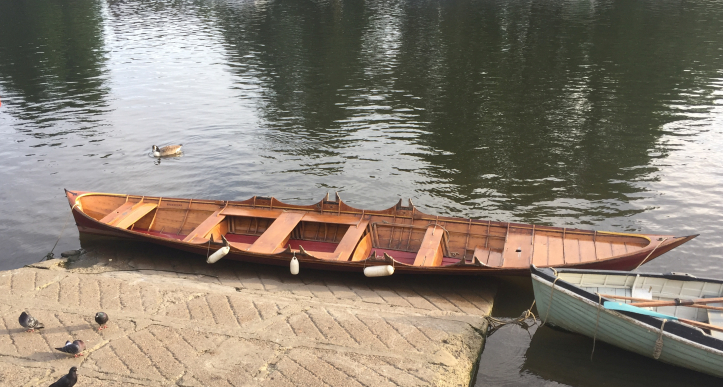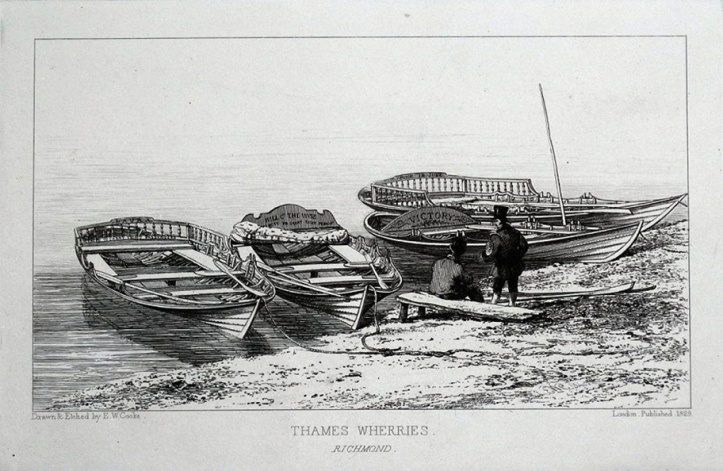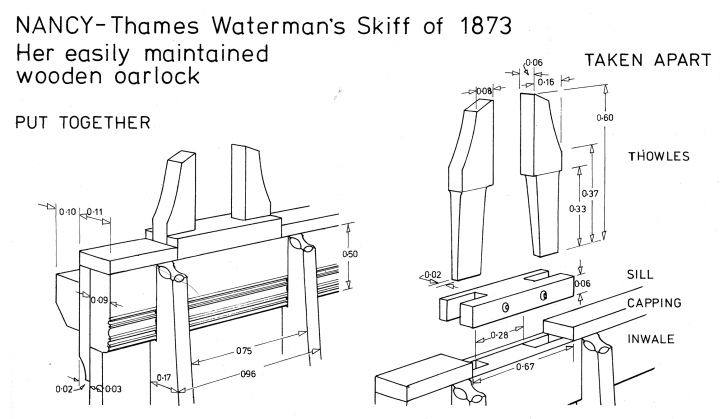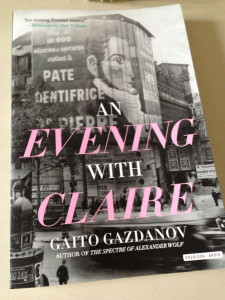 2 June 2017
2 June 2017
On 26 May, HTBS posted an article by Daniel Walker. He had been strolling along the river at Richmond Bridge when he saw an unusual watercraft. Not knowing what it was, he turned to HTBS readers to see if anyone could solve the mystery craft. One reader, who took up the challenge, is rowing historian Peter Mallory. He writes:
 Daniel Walker’s photo.
Daniel Walker’s photo.
This is not a skiff but a Thames wherry, one of the types used around Richmond, with a bow adapted for launching from piers and ramps, as shown in Walker’s photos, and not the long-prowed wherries adapted to the expansive mud flats of the Tideway closer to London. I include another photo of a Richmond wherry (see on top), a replica of Rose in June built by Mark Edwards MBE of Richmond Bridge Boathouses, shown with its accommodation for paying passengers in place. This is likely the same boat that Walker photographed as Edwards’s shop is the white one-story structure shown at the far left of Walker’s first photo. See richmondbridgeboathouses.co.uk
I also include an okay scan of the famous 1829 E. W. Cooke etching titled Thames Wherries, Richmond, showing similar craft. In fact, the original Rose in June is boat 4, numbered from the left. (I own a very nice copy of this etching, but it is framed. I made a hi-res scan before I framed it, but now I can’t locate it. Sorry.)
 E. W. Cooke etching “Thames Wherries, Richmond”.
E. W. Cooke etching “Thames Wherries, Richmond”.
Note that all four wherries in the etching have three main thwarts, with the stern-most rendered unusable whenever the passenger accommodation was present. Indeed, in boats 1 and 2, the only boats where one can peer into the cockpit, the wooden plank that forms the stern thwart is actually removed.
Note also that in boats 1, 2 and 4 (3 is obscured by the waterman’s top hat), just as in the Walker photos, the stroke-side gunwale is constructed to support a stern-most thole, but the pins are missing. As for a lone bow-side thole close to the bow of the boat, one can only confirm for certain that boats 1 and 4 have that feature.
What to make of this? Reportage of watermen’s competitions in Bell’s Life well establishes three preferred configurations of rowers used in Thames wherries during their glory days of the late 1820s and early 1830s:
1) A lone waterman sculling. He could take either the center or the forward of the three main thwarts depending on the need to trim the boat for passengers or cargo.
2) Two watermen, each rowing with a single sweep oar, as in a modern pair. They would take the center and forward of the three main thwarts, and would be free to swap in mid-stream their oars from bow-side to stroke-side and vice versa to rest fatiguing muscles.
3) A ran-dan, three watermen (or two watermen and a gentleman, as in some races in the 1820s), the middle man sculling and the bow-most and stern-most men sweep rowing. A ran-dan was sufficiently rare as to rate extraordinary mention in newspaper coverage.
Two watermen sculling, as in a modern double, was seldom seen done during that era.
Not only the passenger accommodations but also the thwarts were easily removable, either to lighten the craft for competition or to adapt the craft on short notice for carrying passengers or cargo.

How to explain the missing stroke-side thole at the stern-most thwart? Note the included schematic above. Thole pins were quickly and easily replaceable. The stern-most thwart would never be used except in ran-dan configuration, so it is possible to speculate that the bow-side thole pins were carried only as spares. If so, it must have been a standard practice among watermen as at least three of the four wherries in the etching are so configured.
How about the extra bow-side thole in the bow? If the wherry was carrying extraordinary weight in the stern, necessitating two watermen placing themselves far into the bow in order to trim the boat properly, they could sweep row on stroke-side from the bow-most thwart and on bow-side while sitting on the storage box.
These conclusions are part research, part common sense and part speculation. I have not read of anyone researching this topic, and it would be interesting to get more information. I have reached out to Mark Edwards of Richmond Bridge Boathouses and look forward to his response.
Share this:




